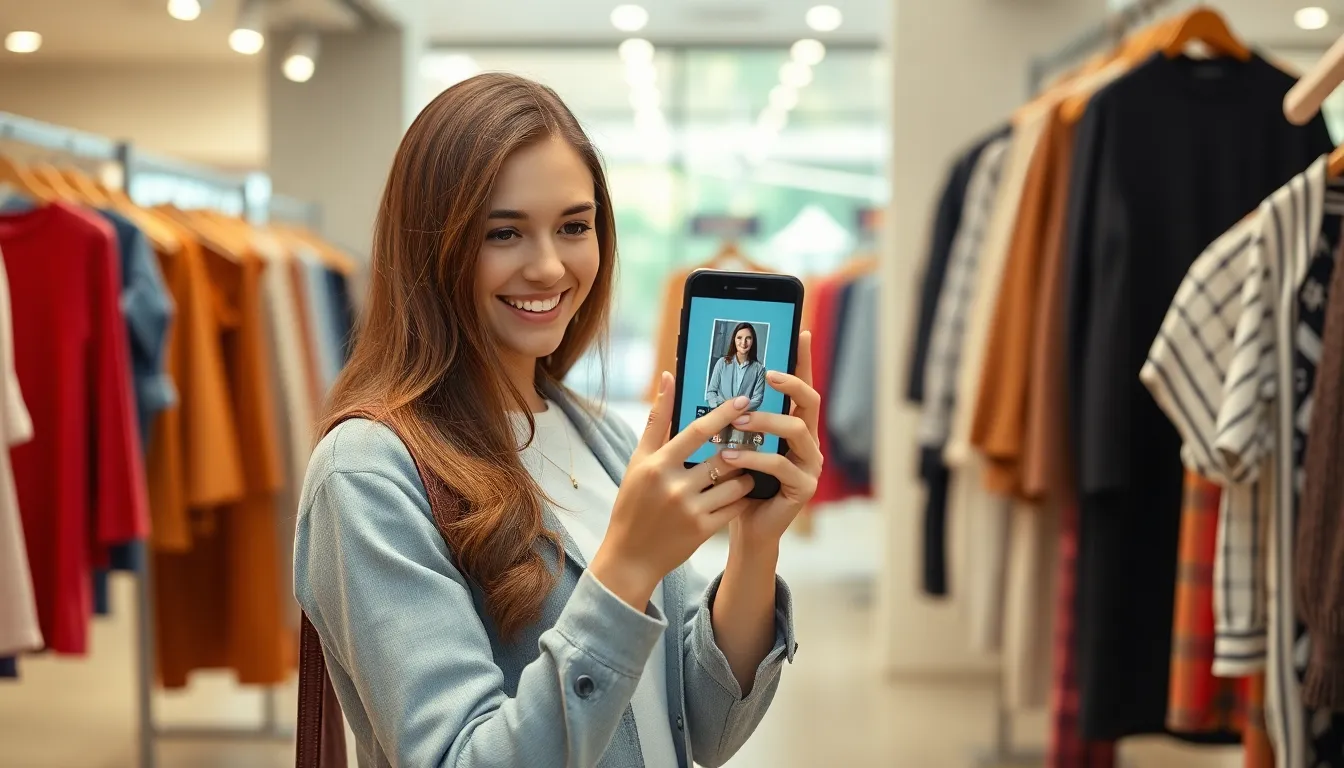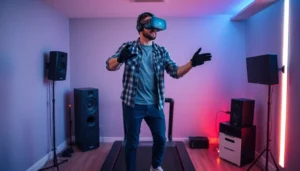Table of Contents
ToggleImagine walking into a store and having the ability to try on clothes without ever stepping into a fitting room. Sounds like magic, right? Welcome to the world of augmented reality in retail, where shopping becomes an experience rather than a chore. Retailers are now using AR to transform how customers interact with products, making it easier and more fun to find the perfect fit.
With AR, shoppers can visualize items in their own space or see how that snazzy jacket looks without the hassle of changing clothes. It’s like having a personal stylist in your pocket—minus the judgmental looks! As this technology continues to evolve, it’s clear that augmented reality isn’t just a passing trend; it’s reshaping the future of retail in ways that are both innovative and entertaining.
Overview of Augmented Reality in Retail
Augmented reality revolutionizes the retail landscape by offering immersive shopping experiences. Customers engage with products in new ways, enhancing both convenience and satisfaction. Virtual fitting rooms allow users to visualize how clothes fit without leaving home. Real-time adjustments enable shoppers to see various styles and colors instantly.
Retailers adopt AR technology to increase consumer interaction and drive sales. By incorporating AR, brands provide unique experiences that capture attention and encourage purchases. A study showed that 61% of shoppers prefer retailers that offer AR experiences.
Retailers witness reduced return rates when using AR tools. These tools help customers make informed decisions, minimizing the likelihood of purchasing unwanted items. Enhanced product visualization plays a critical role in this process.
Leading companies, like IKEA and Sephora, utilize AR to merge online and offline shopping. Customers can see how furniture fits into their homes or how makeup products appear on their skin, improving brand engagement. Such instances illustrate the growing importance of AR in today’s retail world.
As augmented reality continues to evolve, its applications expand. Shoppers increasingly expect interactive experiences, making it vital for retailers to adapt. Investing in AR technology offers a strategic advantage in a competitive market.
Benefits of Augmented Reality in Retail

Augmented reality (AR) offers significant advantages in the retail sector, enhancing both customer interaction and overall satisfaction.
Enhanced Customer Experience
Immersive experiences engage customers on a deeper level. Retailers provide shoppers with virtual fitting rooms, allowing them to try on clothes from the comfort of home. This convenience often leads to a more enjoyable shopping experience. Interactive AR features enable consumers to experiment with sizes, styles, and colors before making a purchase. With 61% of shoppers preferring retailers that incorporate AR, brands gain a competitive edge. AR enhances personalization, making shoppers feel special and understood, increasing their likelihood of returning.
Improved Product Visualization
Product visualization significantly benefits from AR technology. Shoppers can view items in 3D, offering a clearer understanding of dimensions and colors. This clarity aids in decision-making, reducing the chances of dissatisfaction with purchases. Consumers visualize how furniture fits in their homes through AR apps, ensuring selections meet their needs. Enhanced product visualization leads to decreased return rates, as informed customers are likelier to choose products they love. Retailers embracing this technology maintain relevance in a rapidly evolving market and foster lasting relationships with their customers.
Challenges in Implementing Augmented Reality
Retailers face several challenges when implementing augmented reality. Addressing these barriers is crucial for maximizing AR’s potential.
Technology Adoption Barriers
New technology often encounters resistance during adoption. Many retailers find integration with existing systems complicated. Lack of technological infrastructure can inhibit progress, impacting AR deployment. Training staff and educating customers also presents challenges, as both need to adapt to new tools. Consumers may feel overwhelmed by unfamiliar technology, limiting engagement. Retailers must manage these hurdles effectively to reap AR’s benefits.
High Development Costs
Development costs for AR can be significant, posing a major challenge for retailers. Custom AR solutions often require substantial investment in tools and resources. Ongoing maintenance and updates further contribute to long-term expenses. Small to medium-sized enterprises might find these costs prohibitive, hindering their ability to compete. Strategic budgeting and partnerships can help mitigate financial constraints. Balancing costs with potential returns remains essential in leveraging AR technology effectively.
Case Studies of Augmented Reality in Retail
Augmented reality is reshaping retail with successful applications and invaluable lessons. Several companies illustrate the effective use of AR technology, enhancing customer engagement and experience.
Successful Implementations
Sephora employs AR through its Virtual Artist feature, enabling customers to visualize makeup products on their faces without trying them on physically. IKEA’s Place app allows users to place furniture in their homes virtually, helping them see how pieces fit into their space. These successful implementations demonstrate that AR can drive customer interaction while enhancing decision-making. Target has incorporated AR in its app for interactive promotional displays, offering an immersive shopping experience. With 61% of consumers expressing preference for retailers utilizing AR, it’s clear that embracing this technology yields measurable benefits.
Lessons Learned
Retailers face challenges in implementing AR, primarily related to technology adoption. Employees often require training to effectively use AR tools, curbing the technology’s potential. Significant development costs also pose a hurdle, especially for small to medium-sized retailers. Streamlined integration processes with existing systems reduce friction and ease the transition into AR-enhanced shopping. Additionally, successful AR implementation hinges on customer education, fostering comfort and familiarity with the technology. Focused strategy and budgeting form a critical foundation for overcoming obstacles and ensuring lasting success with augmented reality.
Future Trends in Augmented Reality for Retail
Predictive analytics combined with augmented reality offers retailers deeper insights into consumer behavior. New tools will enable retailers to tailor experiences based on individual preferences and shopping patterns. Virtual fitting rooms are evolving; enhanced features allow users to see how different brands and styles fit their unique body types.
Seamless integration with social media platforms is becoming essential. Retailers leveraging AR will allow customers to share their AR experiences directly with friends and followers. Enhanced collaboration between brands and influencers can drive engagement through interactive content, drawing more customers into the shopping experience.
Furthermore, the rise of AR smartphones facilitates widespread access to augmented reality applications. High-quality AR experiences now reach more consumers, leading to greater adoption rates among retailers. Companies like IKEA and Sephora set benchmarks for immersive shopping experiences, prompting others to follow suit.
Also, advancements in AR technology permit realistic product visualizations. 3D model enhancements provide more detailed representations of products, helping customers make informed choices. Retailers will increasingly offer virtual try-ons and visualizations that empower consumers to visualize products in their environment.
Sustainability plays a crucial role in future AR developments. Brands that incorporate AR experiences aimed at promoting eco-friendly practices resonate with environmentally conscious consumers. Retailers must embrace innovative marketing strategies that highlight sustainable products through engaging AR experiences.
As competition intensifies, companies will invest in personalized customer journeys through AR. These tailored experiences enhance customer satisfaction, ensuring loyalty. With statistical evidence indicating that 61% of shoppers prefer retailers offering AR experiences, brands cannot ignore the growing importance of this technology.
Augmented reality is undeniably reshaping the retail landscape. By providing immersive and personalized shopping experiences, it enhances customer satisfaction and engagement. Retailers adopting AR technology not only meet consumer demands but also foster loyalty through innovative interactions.
As AR continues to evolve, its integration with predictive analytics and social media will further enrich the shopping experience. The focus on sustainability and eco-friendly practices through AR will resonate with conscious consumers. Retailers that embrace these advancements are poised to thrive in an increasingly competitive market, ensuring they remain relevant and appealing to their customers.







